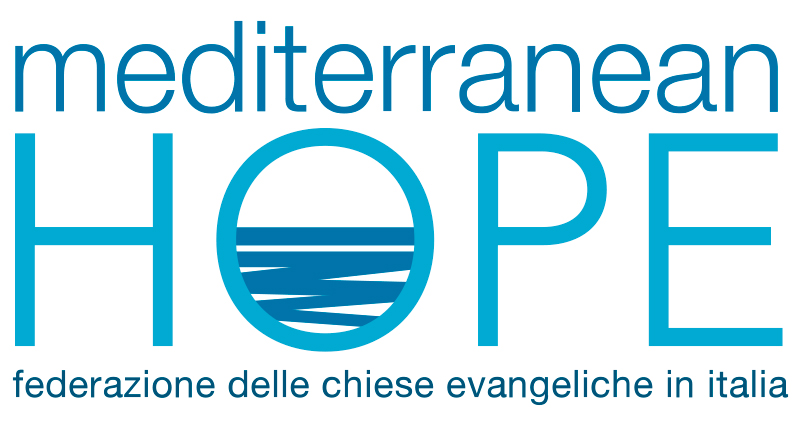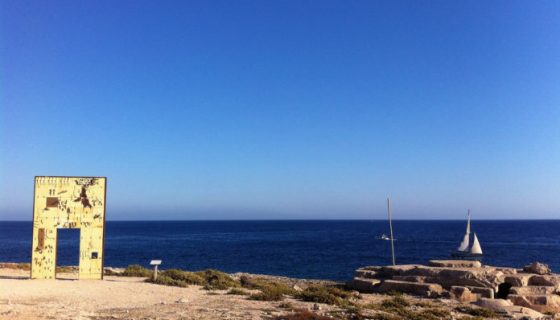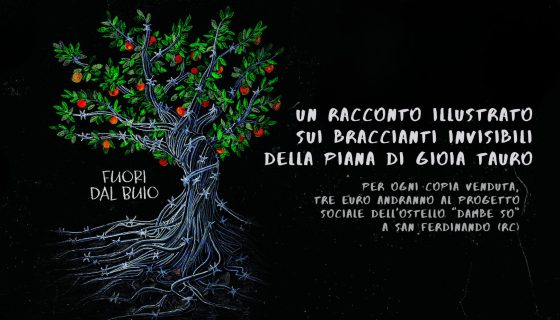- Mediterranean Hope - Federazione delle chiese evangeliche in Italia
- mh@fcei.it
Lampedusa: a border in continuous transformation
by Marta Bernardini and Francesco Piobbichi* Eight months, this is how long we have been in Lampedusa with the Mediterranean Hope project. Eight months are not much to understand and grasp the deeper meanings of this rock in the heart of the Mediterranean, but it is definitely a significant period that adds value to our story (1).
We wondered where to start and what to talk about, in order to give a voice to this place and the people who live here and land here. We believe that Lampedusa’s story should be told starting from an aspect that is fundamental to us: its perpetual mutation as a borderland. A border that rejects or accepts, but always a border that marks the distance between “us” and “them”, between wealth and poverty. Telling the story of Lampedusa after these eight months also, and above all, means talking about how the mechanism and spectacle of the frontier has changed in recent years, and how the border has been moving and relocating to the “sea.” After the Arab Spring of 2011, the island has become a border in “crisis” where the spotlight has been focused on the emergency – as Paolo Cuttitta eloquently describes in his book – but Lampedusa is now undergoing a new mutation. It would be impossible to recount these months in Lampedusa without considering how the Mare Nostrum operation of “humanitarian police” has profoundly changed life on the island, which has been made “peaceful” by the military ships that stop “people smugglers” on the one hand, and “rescue” refugees and asylum seekers on the other. In 2011, it would have been described as an island “invaded” by the emergency of “landings” of “illegal immigrants”. While Lampedusa is perpetually changing, there is nevertheless a date etched in the history and identity of the island, that of 3 October 2013, when hundreds of people perished off its coasts. This event is now imprinted in the minds not only of the people of Lampedusa, but also the rest of the country that is still sensitive to the tragedy taking place in the Mediterranean. The 3rd of October has stirred something in the citizens of Lampedusa, a population living in a place of transit that struggles to find a collective identity. For the people of Lampedusa this has become a date to be defended, to be protected from becoming a media spectacle, and to be declared a day of both remembrance and silence, like a warning so that these tragedies and the unwanted media parades of current politicians are not repeated. This aspect was made clear during this year’s commemorations, which were also characterised by a number of objections, always embedded in and used by that deep-rooted culture and art of sensationalism. In this context, one constant element remains: poor people who were lucky enough to cross the border over seas and deserts, whether rejected or accepted, are denied one of their subjective rights, that is to say, the possibility to seek asylum in safe countries, as provided by the Charter of Human Rights. Meanwhile Italy experienced a paradox in the reception policy during the Mare Nostrum operation: accept and welcome refugees and asylum seekers but at the same time make them feel inferior. Besides, there is no other way to explain the coincidence of the end of Mare Nostrum with the start of Mos Maiorum, a policing operation where migrants rescued from the sea are forcibly identified for days. Working in Lampedusa means, therefore, having a keen insight into these phenomena, without ever losing sight of the social needs of the inhabitants of a frontier island. The island is a symbolic place, a stage, and for this reason the processes of reception and making others inferior can be read in advance. Our experience in the past few months has allowed us to come to the idea that the civilisation of a country is not only measured in the prisons, identification and expulsion centres, reception centres for asylum seekers etc., but also in its borders, the treatment given to people who cross them and the type of rhetoric generated by the media. It is no coincidence that for months the island’s reception centre has remained officially closed with works in progress, even though it accommodates a number of migrants in an “exceptional” way. It is also no coincidence that unclear dynamics are often created between the institutional reception operators when the migrants land. All this is closely related to the redesigning of the role of the border. A border that is not simply a place of arrival for civilians, but also a place, as is happening now in Lampedusa, of new military installations, which generate protests and misgivings from a population concerned about the presence of radars and their effects on health. A militarised island of reception, but also an island of tourism, a moving border that, depending on the political stage and media report, expands south up to Libya or west up to Malta, to then retract behind its coasts. Lampedusa is a border in movement, as are the ships of Mare Nostrum, which in recent months have saved many people, positioning themselves as needed near Lampedusa or near the Libyan coasts. We are now in a phase of transition between Mare Nostrum and Triton, an operation of the European Frontex agency which should replace the first one, but in fact deploys fewer forces and is mainly oriented to monitoring the sea rather than rescuing people. It is still early to understand the full effects of this change, but it is very likely that Lampedusa’s form will change again. It could soon go back to being a place of landing and identification, where some people will be accepted and some will be rejected. All this is taking place without a clear idea of what type of reception centre is present on the island – even though its double walls suggest something – and how many people will be stopped or what type of reception they will receive. We were deeply moved by the story of Dagmawi Yimer, an Eritrean refugee who returned to Lampedusa as a director. He talked about how it was for him to land barefoot on the island and to return today in a different way. He returns here after a journey that lasted years, which involved regaining the dignity lost when one arrives barefoot and defenceless to an unknown land. But this return may allow us to find the thread for a common discussion aimed at fully understanding the logic of the border. Why, one might ask, is there no memory of the thousands of people who have passed through this island? Why have very few people returned to a place that has been a salvation for many people? Maybe they don’t return because Lampedusa is still a place to forget, the first approach with a long series of procedures and measures that have certainly saved them, but that at the same time has helped to make them invisible, “second rate” citizens, blackmailed by laws that instead of protecting them, transform them into vulnerable and weak individuals. However, in the last few months there is a new paradox for a Europe that constructed the migration reception strategy with respect to work. This new aspect is represented by the mutation in the composition of the flows, which no longer consist primarily of economic migrants, but of refugees and asylum seekers. These men and women have a subjective right that is universally recognised in the Declaration of Human Rights, and which Europe is today violating. Today, the boats carry people forced to leave their country in order to escape war and persecution, just as the Jews were forced to do during the Second World War. This consideration should give pause to a Europe that seems to defend certain rights only within their borders, remaining rather indifferent to what continues to take place in the Mediterranean Sea. It is no wonder then that Lampedusa with its constant changes, crossings of people and moving borders, still struggles to find its identity, and perhaps Europe should start to wonder about its own identity. 1) Article taken from Confronti, 12/2014, pages VIII-IX. 2) Paolo Cuttitta, 2012, Lo spettacolo del confine, published by Mimesis. * Operators for Observatory on migration in Lampedusa, Mediterranean Hope





